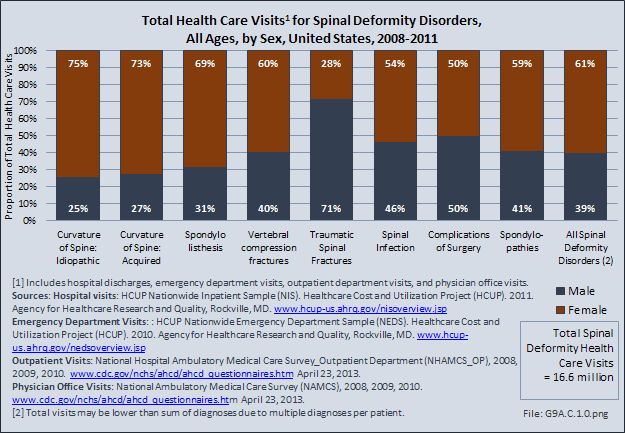

Women are more likely to demonstrate scoliosis, especially adolescent idiopathic scoliosis, than are men. Although a variety of explanations have been presented to account for this, no single sex-based risk factor has been identified. However, females with adolescent idiopathic scoliosis tend to present with larger curves, and the potential role of estrogen in the development and progression of this condition, especially considering the impact of estrogen on bone metabolism and development,1 has been extensively studied. Still, no clear-cut influence on the onset or progression of idiopathic scoliosis has been identified. Older age at the onset of menarche has been found to be associated with an increased likelihood of presenting with a more significant curve among patients with adolescent scoliosis. However, specific estrogen polymorphisms have not been consistently correlated with age at menarche or curve severity.2
Although women represent 51% of the total population, they have a greater than expected rate of health care visits for the majority of spinal deformity disorders. This is particularly true for both idiopathic (75%) and acquired spinal curvature (73%), and for spondylolisthesis (69%), a spinal condition that causes one of the lower vertebra to slip forward onto the bone directly beneath it. Traumatic spinal fractures occur at a greater extent to men, while vertebral compression fractures, often due to osteoporosis, occur much more frequently in women. Spinal infections and complications from surgery related to spinal deformity occur about equally between men and women.
Spondylopathies, which refer to any disease of the vertebrae associated with compression of peripheral nerve roots and spinal cord, causing pain and stiffness, were diagnosed more frequently (59%) in health care visits by women than by men (41%).
Overall, on an annual average, 16.6 million health care visits for spinal deformity conditions were made each year in the years 2008 to 2011. Of these visits, 61% of those treated were women. (Reference Table 9A.3 PDF [1] CSV [2])

Links:
[1] https://bmus.latticegroup.com/docs/T9A.3.pdf
[2] https://bmus.latticegroup.com/docs/T9A.3.csv